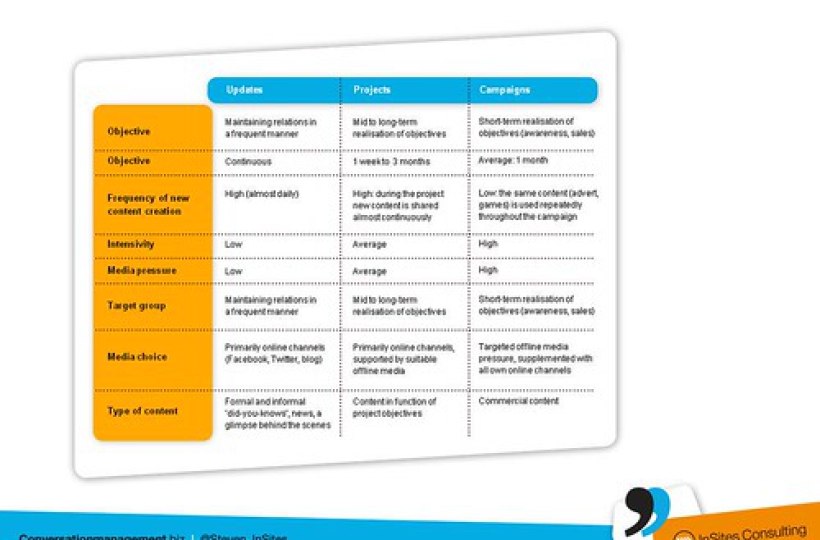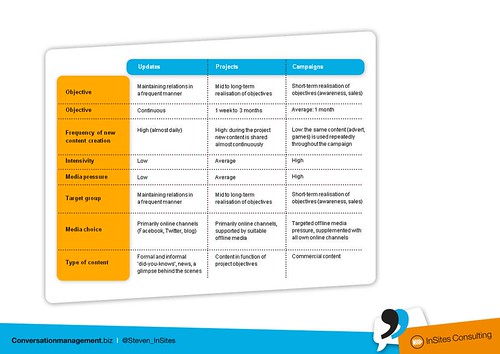Content Marketing Step 3: Editorial content planning

Today we discuss the third step of our pragmatic content marketing approach: planning. Selecting a topic is fine, having a strategy and conversion plan ready is great, but the difference is made during the execution. After agreeing on the topics you want to focus on, the next step is to plan your content. To do so, you should make use of three content streams: content updates, content projects and content campaigns.
Updates
Updates are short messages which you send with a certain degree of regularity. Updates are usually a combination of formal (facts and figures, news, recruitments, etc.) and informal (culture, staff news and events, a look behind the scenes, etc.) content. These are content pin-pricks which allow your fans and followers to keep abreast of all the important and not-so-important developments in their favourite company. Updates are usually shared via social media. They keep your company in the thoughts of your customers.
Projects
Projects run over a longer period and are usually related to a particular theme. For example, a project might be a product launch, the opening of a new department, an important research study, a major customer event or a recruitment drive. The company develops content relating to the theme on a regular basis over a longer period, varying from one week to three months. Projects work towards a specific objective and the content is planned in relation to that objective. This content (regular small and large pin-pricks) is primarily shared via online channels, but can be supplemented by offline media. A project can also be supported by means of a campaign (see below). Projects put the focus on a certain aspect of your company.
Campaigns
Campaigns are shorter and more intensive than projects and are frequently supported with offline media. This content is designed to increase awareness of your company or to announce important news (e.g. a new product). All available media are employed to force a specific short-term result (usually increased visibility and sales).
Creating this framework and ensuring the smooth flow of the three different streams is not an exact science. They do, however, give you a solid basis for action. Try to think in terms of these three streams and draw up your content planning in function of your company-specific objectives. The easiest and most practical way to do this is by drawing up an Excel spreadsheet in which you fill in the details of the things you want to talk about and the resulting content that will need to be created for each stream and each quarter. More specifically for example, an update might consist of a daily blog post, a Facebook update or a number of Twitter messages. A project might cover the Christmas period, if this is important for your company (for example, if you are a food and drinks manufacturer). During this period, you must provide content relevant to the theme on a daily basis. Your company may need to manage different projects consecutively (one for whiskey and one for champagne). A campaign might be the launching of a new product, where you want to see results as quickly as possible and consequently deploy every means at your disposal.
The combination of these three streams will gradually result in the widening of your reach and engagement. The updates will ensure a steady influx of newly interested parties. The campaigns will boost your reach dramatically for a short period. Because campaigns are expensive, you need to think carefully how you use them. Organise them at the right time and in the right place. Use updates and projects to usefully maintain customer interest in the periods between campaigns. That is how you will keep in touch with the people who are interested in your company all year round.
[slideshare id=11438613&doc=asixstepcontentmarketingmodel-120206005134-phpapp01]
